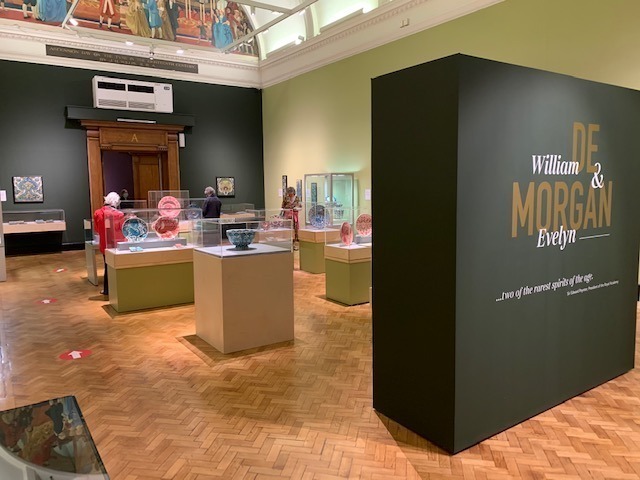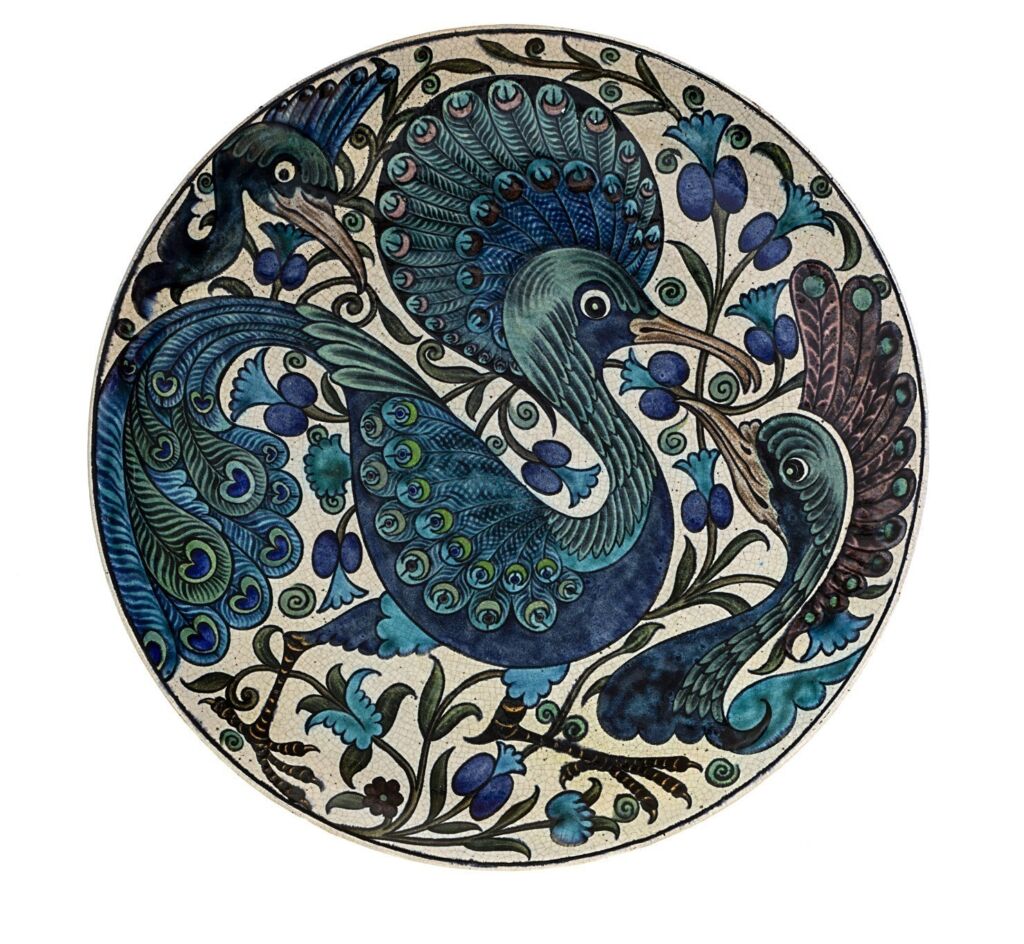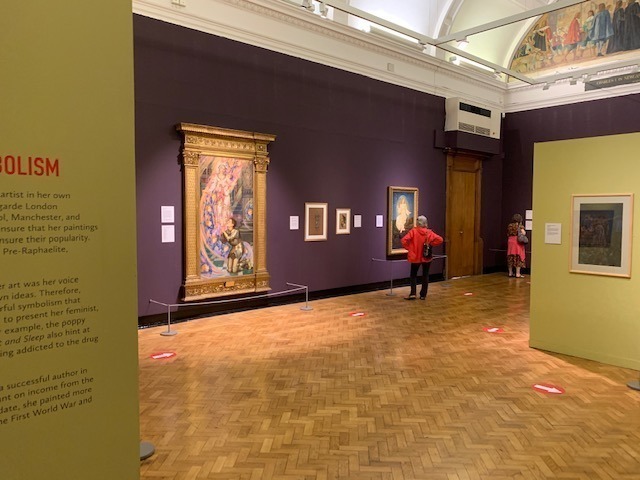Who were the De Morgans? David Whetstone went to the Laing Art Gallery – open again now with special measures in place – to find out about the once celebrated couple and their art.
![Night and Sleep by Evelyn De Morgan (1878) © De Morgan Collection, courtesy of the De Morgan Foundation (sm[13113]](https://www.only-in-newcastle.co.uk/wp-content/uploads/2020/08/Night-and-Sleep-by-Evelyn-De-Morgan-1878-©-De-Morgan-Collection-courtesy-of-the-De-Morgan-Foundation-sm13113.jpg)
Night and Sleep by Evelyn De Morgan (1878) © De Morgan Collection, courtesy of the De Morgan Foundation
A greeting at the door, no less friendly for coming from behind a mask, means the Laing Art Gallery is welcoming visitors again, although in a way compliant with these strange times.
Masks, hand sanitiser and arrows are part of the now familiar drill and visitor flow is being monitored.
What William and Evelyn De Morgan would have made of it all is anyone’s guess.
But doubtless they would have been delighted to see their art as the latest ticketed attraction at the Laing – and quite a potent one judging by the steady turnout on a weekday morning.
“These tiles are gorgeous,” ventured one of a small group of mask-muffled ladies, feasting their eyes.
William and Evelyn De Morgan: ‘Two of the Rarest Spirits of the Age’ (to quote Sir Edward Poynter, Royal Academy president, 1896 to 1918) does indeed offer visual and intellectual stimulus to art lovers let off the lockdown leash.
But you might not have heard of the De Morgans. This is the first time the De Morgan Collection has been shown in the North East, according to its curator and manager, Sarah Hardy.
In art historical terms, the careers of this creative couple bridged the Pre-Raphaelites and the Arts & Crafts movement.
William Morris, Arts & Crafts prime mover in the late 19th Century, was a friend and collaborator of William De Morgan and Evelyn was the niece and pupil of a Pre-Raphaelite painter, John Roddam Spencer Stanhope.
I warmed to them immediately. They seem to have been a happy couple, even if the First World War blighted their final years.

The William & Evelyn Morgan exhibition at The Laing Art Gallery in Newcastle
They met at an artistic fancy dress party where Evelyn Pickering was done up as a tube of rose madder paint. William, 16 years her senior, joked that he was “madder still” and it proved to be the quip that hooked a bride.
The couple were married in 1887 and stayed together until his death in 1917 (she died two years later, aged 63).
William’s ceramics come first in the exhibition and are hugely seductive, their metallic glazes glistening under the lights.
His magpie eye was drawn to the imagery of the ancient Islamic world and he enthusiastically adopted and adapted it for his own designs, of which more than 1,200 exist.
Nature and imagination played their part, so fantasy creatures cavort with real ones, as in the fabulous Ferocious Creatures vases with their dragons, lizards and snakes.
Displayed side by side, Peacock dish (blue) and Peacock dish (red) vie like the birds they depict for visual one-upmanship. Peacocks were favourites of the expert potters of Iznik, in Turkey, whom William sought to emulate.
Even today, this is covetable stuff.

Fantastical Peacock Plate, 1888 – 1907, William de Morgan © De Morgan Collection
William started small, buying blank tiles from Wedgwood and others to decorate and fire in the garden of his terraced home in Chelsea, but with success came the need to expand.
He moved first to Merton Abbey, close to the influential Morris, and then to Fulham where he ran a sophisticated set-up with architect Halsey Ricardo.
An early contract for De Morgan & Co. was with a Norwich stove manufacturer to provide decorative tiles for Victorian and Edwardian hearths. Some will still be a popular ‘original feature’ in today’s property market.
P&O turned to the firm to fire some classy decoration for its fleet of cruise liners.
The vessels’ seagoing days are gone but a photo shows the stunning Arab Hall at Leighton House in London (now the Leighton House Museum) whose lustrous tiled surfaces remain a monument to the De Morgan brand.
Despite all this, William’s firm folded in 1907. His strengths lay on the creative rather than the revenue side of the business but no matter. He cheerfully reinvented himself as a successful novelist.
In the second of the Laing galleries you enter the intricate world of Evelyn De Morgan whose paintings reflected her early feminism and sense of fair play.
Evelyn supported women’s suffrage and was one of the first students at the Slade School of Fine Art where female students were permitted to paint male life models.
Already well established when she met William dressed as a tube of paint, she would soon find he shared her pacifism and interest in social reform.
Pretty soon she also met his mother, Sophia, a spiritualist medium who claimed to put people in touch with their dear departed. This, too, Evelyn embraced.
Spiritualism had a keen following during her lifetime, perhaps because many more lives were cut short. Now it adds a dash of period eccentricity to this side of the exhibition.
In a display case is a book called The Result of an Experiment which Evelyn published anonymously in 1909.
It contains supposed messages from the spirit world, including this one visible on the open page: “I am a miserable spirit. I am forced to write. I made my earth-life hideous. I was ill-natured and quarrelsome.”
You wonder who was meant to benefit from prodding this glummest of ghosts (alleged) into sharing its woes.

Evelyn De Morgan’s Laing exhibition in Newcastle
There’s a disturbing side to Evelyn’s art. Life, death and the passing from one to the other, with snakes and dragons occupying the chasm into which one might fall, are perhaps not subjects that speak volumes to a 21st Century audience.
But she did champion women, putting them front and centre. In the oil painting Lux in Tenebris (Light in Darkness), from 1895, the Christ figure is a young woman in a yellow dress.
And in the spectacular Our Lady of Peace, almost iridescent after recent restoration, a knight’s vision of the Virgin Mary includes a rainbow cascade of six-winged cherubs.
The massively framed painting dates from 1907 and was created after the Boer War as an expression of hope and reconciliation.
That hope proved forlorn. The horrors of 1914-18 dismayed and galvanised Evelyn. She put on an exhibition to raise money for the Red Cross and some of the work, expressing her deep sorrow, is shown here.
Sadly, a lot of Evelyn’s paintings were destroyed in a warehouse fire in 1991 but some of the studies that preceded them are among the most appealing work on display.
Free from melodrama, metaphor and symbolism, her delicate sketches of heads and hands have a simple beauty.
My favourite among her large paintings dominates one wall. Night and Sleep, inspired by Botticelli and done in 1878, has the male figure representing the former whisking the latter through the sky.
She scatters poppies. How pretty! And how poignant when seen as a premonition of Flanders fields! But the accompanying text tells us Evelyn was subtly alluding to the distillation of poppies to make laudanum, prescribed to Victorian women for ‘hysteria’.
Evelyn was a commercially successful artist but she didn’t sell out. She used her art to point the way to a better world.
William and Evelyn De Morgan: ‘Two of the Rarest Spirits of the Age’ is on at the Laing until September 26. There is an admission fee. Book and find details here.
• Other venues run by Tyne & Wear Archives & Museums are now open again with special precautions in place. They include the Shipley Art Gallery in Gateshead, South Shields Museum & Art Gallery, Segedunum in Wallsend and Arbeia Roman Fort in South Shields. Great North Museum: Hancock and the Discovery Museum in Newcastle are due to reopen on September 1.
